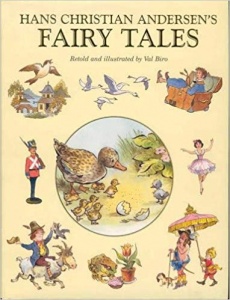Hans Christian Andersen First Book of Fairy Tales
Listen to the Recess! Clip
| Author | John Cech |
| Air Date | 11/30/1999 |

Hans Christian Andersen Transcript
Tomorrow marks the anniversary of the publication in 1835 of the first volume of Hans Christian Andersen’s Fairy Tales, Told for Children. Andersen called it his first booklet; in it were “The Tinderbox,” “Little Claus and Big Claus,” “The Princess and the Pea,” and “Little Ida’s Flowers.” Of these four stories, three were “tales that I had heard as a child,” Andersen wrote, ” either in the spinning rooms or dung the harvesting of the hops.” Only the tale of Little Ida was an original story, for a little girly by the same name, the daughter of a poet friend of Andersen’s. He wanted to keep “the presence of the storyteller” in the language, and you can hear the verbal swagger in the first line of “The Tinderbox”: “A soldier came marching down the road: left . . . right! Left . . . right! He had a pack on his back and a sword at his side. He had been in the war and he was on his way home. ”
Andersen is 30 when he writes this, and already he has been through his own kind of wars — born the son of a poor washerwoman and a melancholy cobbler from the Danish coastal town of Odense, he’d had to endure the grinding poverty of his childhood and youth, the desperate, depressing struggle for a lad from the wrong social class to climb the ladder of literary success, the unhappiness in his romantic life, the restless travelling. He was, he informs us, the ugly duckling, the lowest in the town’s pecking order , the brunt of crude jokes and coarse criticism. Famous as he would later become, he never quite got over those early traumas, or the later scars. But they became the fuel that drove his fantasies and gave substance to his stories. “Most of what I have written,” Andersen says in his autobiography, The Fairy Tale of My Life, ” is a reflection of myself. Every character is from life. I know and have known them all.”
The tales came out this way for the next thirty-some years, a handful a year, but soon they were pouring out, and in the end Andersen wrote 156 “tales and stories,” a dozen or so of which are among our best-known fairytales. Perhaps the key to his success was, as he told a friend early on, lay in the fact that he could “seize an idea for the adults — and then tell it for the children while still keeping in mind the fact that mother and father are often listening too, and they must have a little something for thought.” Indeed they do: like remembering being ugly ducklings too.